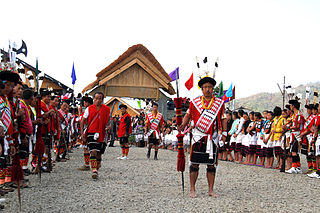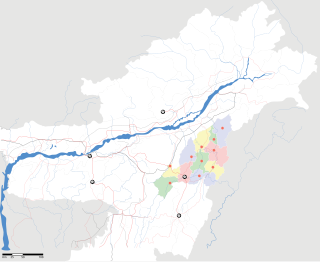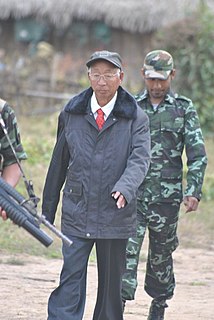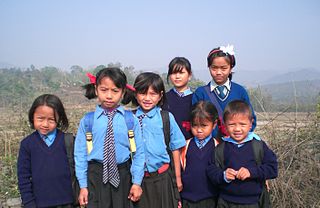Related Research Articles

Nagaland is a state in northeastern India. It is bordered by the state of Arunachal Pradesh to the north, Assam to the west, Manipur to the south and the Sagaing Region of Myanmar to the east. Its capital city is Kohima and its largest city is Dimapur. It has an area of 16,579 square kilometres (6,401 sq mi) with a population of 1,980,602 per the 2011 Census of India, making it one of India's smallest states.
The Indian state of Arunachal Pradesh has a total population of roughly 1.4 million on an area of 84,000 km2, amounting to a population density of about 17 pop./km2 . Much of Arunachal Pradesh is forested. The "indigenous groups" account for about two thirds of population, while immigrants, mostly of Bengali/Hindi belt origin, account for a third.
Nagas are various ethnic groups native to northeastern India and northwestern Myanmar. The groups have similar cultures and traditions, and form the majority of population in the Indian state of Nagaland and Naga Self-Administered Zone of Myanmar; with significant populations in Manipur, Arunachal Pradesh and Assam in India; Sagaing Division and Kachin State in Myanmar.
Angami Zapu Phizo (1913–1990) was a Naga nationalist leader with British Nationality. Under his influence, the Naga National Council asserted the right to self-determination which took the shape of armed resistance after the Indian state imposed the Armed Forces Special Powers Act in 1958. The Naga secessionist groups regard him as the "Father of the Naga Nation".

The Naga Hills, reaching a height of around 3,825 metres (12,549 ft), lie on the border of India and Burma (Myanmar). They are part of a complex mountain system, and the parts of the mountain ranges inside the Indian state of Nagaland and the Burmese Naga Self-Administered Zone are called the Naga Hills. The highest point of the Naga hills is Mount Saramati.

The Ao Nagas are a major Naga ethnic group native to Mokokchung District of Nagaland, Northeast India. Their main territory is from Tsula (Dikhu) Valley in the east to Tsurang (Disai) Valley in the west in Mokokchung district.

Mon district (Pron:/mɒn/) is a district of Nagaland, a state in India. Mon district is the third-largest district in Nagaland in terms of area. The district has a population of 250,260 people. The district headquarters is Mon.

The ethnic conflict in Nagaland, in northeastern India, is an ongoing conflict fought between the ethnic Nagas and the governments of India and Myanmar. Nagaland inhabited by the Nagas is located at the tri-junction border of India on the West and South, north and Myanmar on the East.

The National Socialist Council of Nagaland (NSCN) is a Naga nationalist separatist group operating mainly in Northeast India, with minor activities in northwest Myanmar (Burma) until 2012. The main aim of the organisation is to establish a sovereign Naga state, "Nagalim", which would consist of all the areas inhabited by the Naga people in Northeast India and Northwest Myanmar. The NSCN's slogan is "Nagaland for Christ". The group is currently fighting for the separation of Nagaland from India.
Naga nationalism is an ideology that supports the self-determination of the Naga people in India and Myanmar, and the furtherance of Naga culture.

The Liangmai tribe inhabits Nagaland and Manipur states of Northeast India. Their villages are mostly spread across Peren district in Nagaland and Tamenglong, Senapati in Manipur. There are also few villages in Dimapur, Imphal East and Imphal West districts. The Liangmais are the main inhabitants and dominate in Tening town, sub-division of Peren district of Nagaland state, and Tamei town, sub-division of Tamenglong district of Manipur state.
Khiamniungan is one of the major Naga tribes, with approximately 35% of the population found in Noklak district of Nagaland, India and the rest in Naga Self Administered Zone and Hkhamti district of Myanmar. They were also called Kalyo-Kaneu during the British Raj.

Yimkhiung is a Naga tribe whose traditional territory includes Tuensang and Kiphire district in the Indian state of Nagaland and western areas of Burma.
Makury, or Makury Naga, is a Naga language of India and Myanmar. Shi (2009:3) and Saul (2005:25) suggest that Makury may be an Ao language.

Shangwang Shangyung Khaplang was a Burmese leader of National Socialist Council of Nagaland, an insurgent group that operates to establish Greater Nagaland, a sovereign state bringing all Naga-inhabited areas of Myanmar and India under one administrative setup.
The Para tribe is one of the tribal Naga peoples. They reside mostly in the Naga Self-Administered Zone in Myanmar. They are one of the major Naga peoples of Myanmar and mostly inhabit the area around Lay Shi Township.

The hill tribes of Northeast India are hill people, mostly classified as Scheduled Tribes (STs), who live in the Northeast India region. This region has the largest proportion of scheduled tribes in the country.
The Tikhir tribe is one of the Naga tribes that mostly reside in Nagaland, India. They are listed as a Scheduled Tribe, in the official Census of India. However, due to lack of official recognition from Government of Nagaland are considered sub-tribe of Yimchunger tribe. The word "Tikhir" means "Dew People", meaning they were the first settlers of the place as they brush up the dewdrops.
The Chirr tribe is one of the Naga tribes that mostly resides in Nagaland, India. They are listed as a Scheduled Tribe, in the official Census of India. However, due to lack of official recognition from Government of Nagaland are considered sub-tribe of Yimchunger tribe.
References
- ↑ "Census of India 2011". MHA, Govt of India.
- ↑ S. R. Tohring (2010). Violence and identity in North-east India: Naga-Kuki conflict. Mittal Publications. pp. xv–xvii. ISBN 978-81-8324-344-5.
- ↑ "Nagaland making peace in a divided land". Frontier Myanmar. 7 August 2019.
